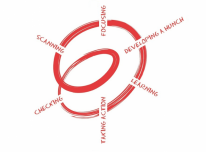A framework for transforming learning in schools: Innovation and the spiral of inquiry
by Helen Timperley, Linda Kaser and Judy Halbert
Overview
Spiral of Inquiry Paper - Timperley Kaser Halbert (PDF 993 kB)
We have been fortunate to receive permission to add the PDF of this paper to Educational Leaders.
This paper argues for a “sea change in learning settings for young people”. Using a range of examples from New Zealand, Australia, and Canada, this paper makes the case for new approaches to designing learning and teaching and how we might achieve this. It also provides a model for long term PLD within schools.
The paper focuses on a rethink of the cycle of inquiry (2007) to the spiral of inquiry. One of the important differences in this new approach is involving learners, their families, and communities in inquiries.
The authors explain how the spiral of inquiry differs from the cycle of inquiry. They provide "boxes" to assist with PLD. The authors walk the reader through the framework and illustrate it with examples.
The spiral has six parts and makes more explicit the process of developing collective professional agency either within a school or across a cluster. Another difference is the link to the seven principles of learning (boxes 1 and 2, pages 5 and 8) listed in the OECD publication The Nature of Learning (Dumont et al, 2010).
Graphic credit: Judy Halberg and Linda Kaser (2013)
The six parts of the spiral of inquiry:
-
Scanning
What’s going on for learners? More emphasis is placed on teacher observations of students, in all circumstances. There are some difficult questions to ask, such as: Is it all right for some learners to experience challenging and engaging learning in one classroom while in the room next door the students are not? Scanning is not done overnight, can last two months, and may turn up surprises. -
Focusing
Where will concentrating our energies make the most difference? Focusing well will lead to informed actions, and usually means selecting no more than one or two areas so that the inquiry is "focused and deep". The authors point out that a common focus generates the momentum to transform schools. -
Developing a hunch
How are we contributing to the situation? "Hunch" is an important word – hunches may not be totally accurate, but it is essential to get them all on the table because they guide the focusing. Sometimes they might be well-established routines of the school or the classroom, and be relevant to your own school. Hunches need testing. -
New learning
How and where will we learn more about what we do? Teacher learning must be connected to identified learner needs. External expertise is important here and the school must make clear to externals what makes a difference to learners. We all need to know why new ways of doing things are better than what we did before. -
Taking action
What can we do differently to make enough of a difference? "Genuine inquiry needs space to take risks, make mistakes, and try again – and again". Changing things can also feel risky for some learners who then resist change, and in turn bring concerned parents. We need to build understanding for all, right from the outset. -
Checking
Have we made enough of a difference? Checking doesn’t have to be formal, or at a set time. It can go on throughout the spiral. The importance of trust should be a recurring theme throughout the cycle, and it certainly is true of checking.
One spiral of inquiry leads to another. Small changes create the confidence to design and implement more radical change. This is how transformation begins. The authors say, "We believe this is more likely to happen if young people are learning in engaging and innovative settings where curiosity – for everyone – is a way of life".
Reflective questions
- Use boxes 1 and 2 with your communities, students, teachers, and the senior leaders to assess how ready you are to use the spiral of inquiry to transform your school. Decide with them whether you will work in a cluster of schools or within your own school.
- Go through boxes 3–8 with your teachers, leaders, and with the students to ensure that you all understand the spiral of inquiry, and the amount of risk-taking and trust that is involved in it.
- How will you use external advisors or expertise to assist you in this process? Make sure you develop a relationship between your external advisors and your school. What will you do to make sure that external advisors, teachers, and students all understand what differences you want to make to the school and the learning that will take place within it?
- How will you develop and use the curiosity of your whole community to transform your school (or cluster) to make it the kind of educational culture that will provide dignity and purpose for each young person?
References
Timperley, H., Kaser, L., and Halbert, J. (2014, April). A framework for transforming learning in schools: Innovation and the spiral of inquiry. Centre for Strategic Education, Seminar Series Paper No. 234.
Dumont, H. et al (2010). The Nature of Learning: Using research to inspire practice. OECD Publishing.
Further reading
Kaser, L., and Halbert, J. (2017). The spiral playbook. c21canada.org
Spiral of inquiry: Leaders leading learning
A resource with field-tested ideas, tools and approaches, and stories about creating inquiry-based professional learning cultures using the spiral of inquiry as its framework.
Tags: Collaborative practice

